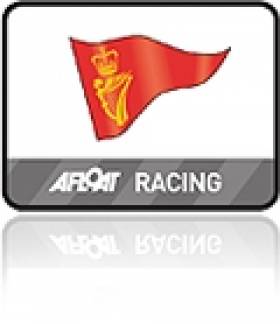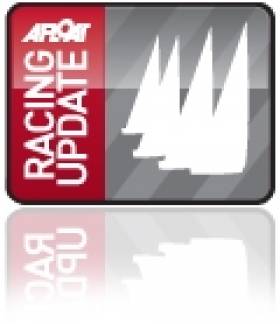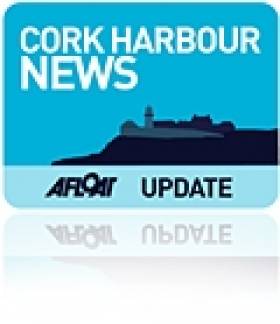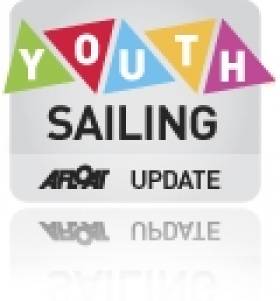Displaying items by tag: Royal Cork Yacht Club
Cork Institute of Technology Win 2010 Student Yachting Nationals
Last weekend saw the Student Yachting Nationals take place at the Royal Cork Yacht Club. The students had the use of the ISA J80 Sailfleet for the event. Six college teams entered for the Nationals which was the Qualifier for the Student Yachting World Cup 2011.
Racing was scheduled for Cuskinny on Friday and conditions were ideal with 17-20 knots of breeze. Race Officer, Nathan Kirwan, got in four good races lasting some 40 to 50 minutes each. However, spinnakers were banned as some wipeouts had been observed by the ISA Bosun who exercised his judgment in this regard. Some two minutes after the start of the first race UCC skippered by Robert O'Leary suffered a snapped halyard but were refused redress. CIT skippered by George Kenefick lost their only winch handle overboard some three minutes before the start in race 1 but still managed to win the race by a comfortable margin. In race 2 UCC came back strongly to take the gun and pushing CIT into second place. At this stage match racing had begun between the two Cork colleges with each throwing dummy tacks to try to clear their air. In Race 3 TCD skippered by Alistair Kissane took the win with CIT in second and UCC third. The final race of the day was won by CIT with UCC third. Overall standings for Day One were: CIT 6pts, with UCC and TCD on 12 pts each. UCD had got off to a shaky start which was to prove costly for them as they were on form on days two and three.
On day two the Race Officer moved the course to the Curlane Bank and spinnakers were permitted. CIT found their rythym taking the bullet in race 5 with UCD in second and a poor mark rounding relegated UCC to third place. Race 6 saw the O'Leary and Kenefick teams doing circles at the pre start as the competition was intensifying and it was looking like a two horse race. UCC took first place with NUIG taking second and CIT third. Donagh Good of CIT went for a quick dip in the cold water but managed to grab on and was pulled back on board by George Kenefick and Kevin Goulding. Later during day 2 the wind was rising to 22 knots so spinnakers were once again banned. UCC found the conditions very much to their liking, taking the win, with TCD in second, UCC third and CIT fourth. Race 8 proved to be rather interesting with CIT managing to relegate UCC to last position and managing to keep UCC in their sight for the duration of the race. Downwind was difficult for CIT with UCC right on their tail but UCC were not successful in finding a passing lane. Again, UCD took their second bullet of the day with CIT and UCC in fifth and sixth positions some four to five minutes behind the rest of the fleet. CIT were able to discard their fifth position but UCC were unlucky in having to count their sixth as they also had a sixth from day one. TCD again got a second position. Results after day two were: CIT 14pts, UCC 19pts, UCD and TCD on 21pts each.
Day 3 was a non discardable coastal race from Crosshaven to Kinsale counting for 1.5pts. The start line was just off Roches Point with five knots of breeze and brilliant sunshine. UCC led the fleet and NUIG and CIT were in last position 300 metres behind the rest of the fleet. As the race went on the wind increased to a nice south westerly breeze of 12 to 14 knots. As this stage it looked as if it might be UCC's lucky day but Team CIT maintained their composure and by tacking close to the shore and keeping out of the tide managed to finish in third position at the Bulman Buoy with UCC first and UCD second. This result was to prove sufficient to give CIT the national student title for 2010.
Overall Results:
CIT 18.5pts
UCC 20.5pts
UCD 24pts
TCD 28.4pts
NUIG 33pts
UL 40pts
80 Boats for Royal Cork Autumn League (PHOTOS HERE!)
An 80 boat fleet set sail for the opening day of the Autumn League at the Royal Cork Yacht Club Regatta today writes Claire Bateman.
While conditions setting out were typical of a lovely Autumn day, the wind, however, was to prove fickle going up and down changing direction. As a consequence of this Race Officer David O'Brien with the Red fleet made up a course to suit the conditions and Race Officer Richard Leonard brought the Green fleet to the Eastern bank where they were to sail a laid course. The Whitesail fleets sailed an extra leg to their race as they have decided to have only one race each day.
The Red fleet started their first race at Whitebay and went to a laid mark on the eastern shore before spinnkaers were hoisted to be dropped shortly afterwards as they headed for OFE 2 before fetching across to Ringabella and running in to a finish at no. 5. Race 2 saw a beat out to W2 for Classes Zero, One and 1720s and a run back to No.11 where the course was shortened. Shortly after the start of the race a shower came and with it some wind but when the rain stopped the wind died resulting in the shortening of the course. Class 2 were also given a beat out to W2 but they were given a shorter course finishing at No. 7.
As usual we had welcome visitors from Kinsale, Dungarvan, Waterford and Cobh participating. It was good to see Jump Juice back in the water as it also was to see Indulgence back in action again. And perhaps best of all was to see a resurgence of 1720s back on their home waters in Cork Harbour.
Prize giving took place immediately after racing and the prizes were distributed by Irene O'Donovan a Partner in the sponsor firm of O'Flynn Exhams Solicitors.
Racing will continue next Sunday with first gun at 10.55am.

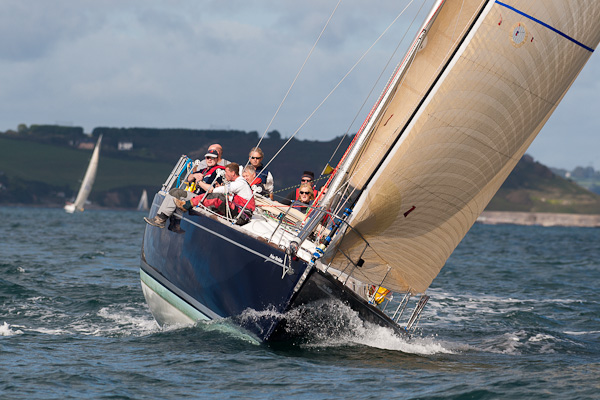
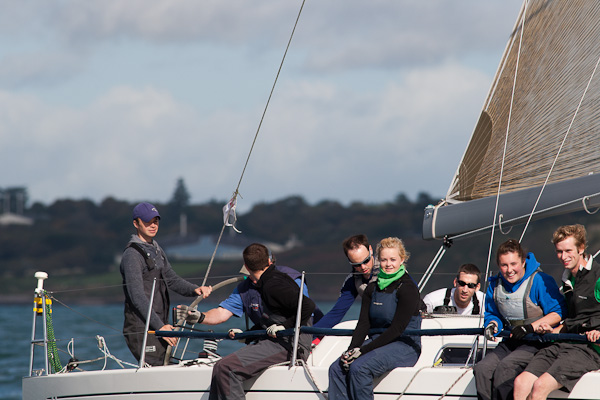
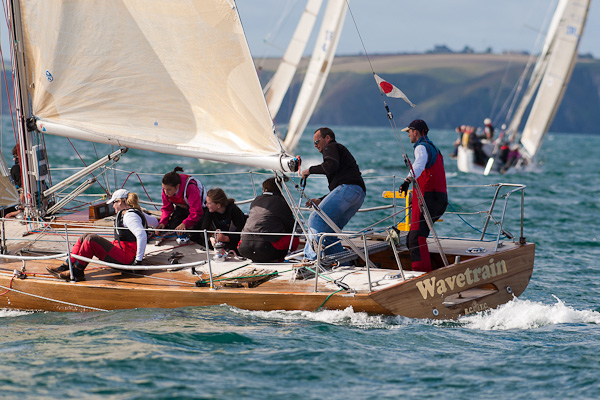
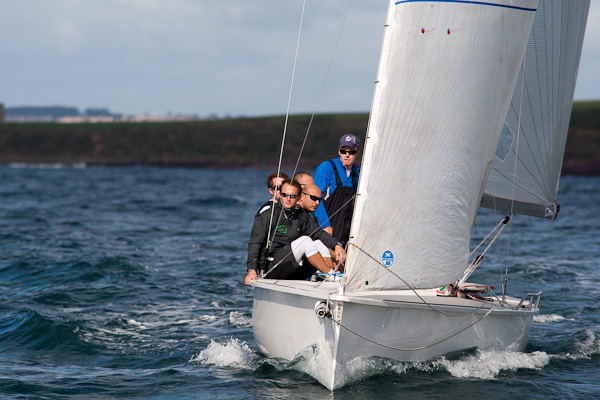


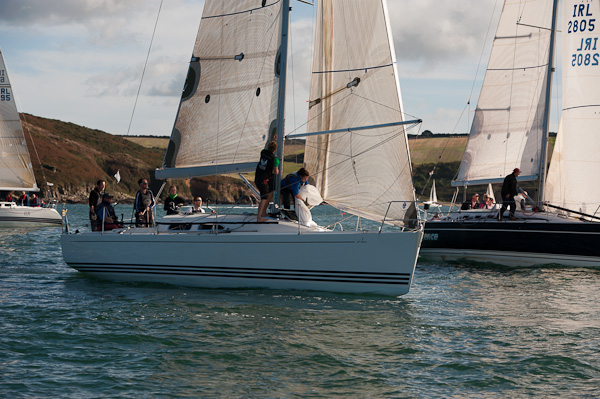
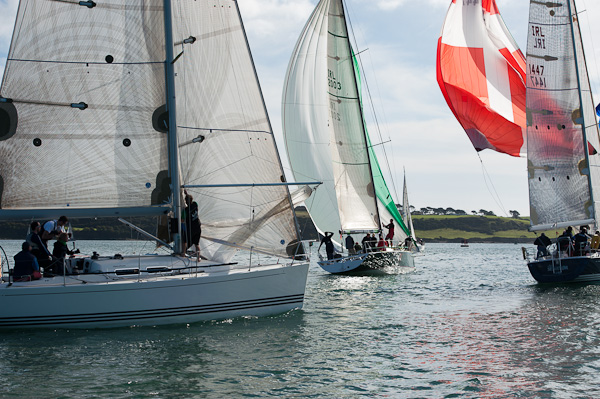

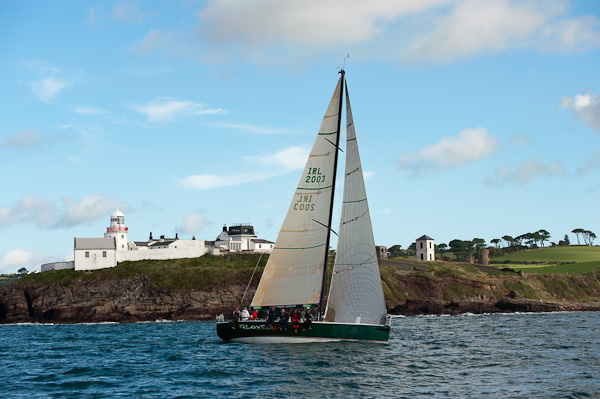
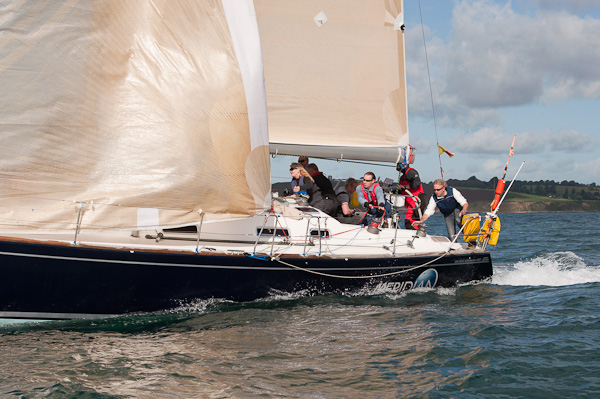
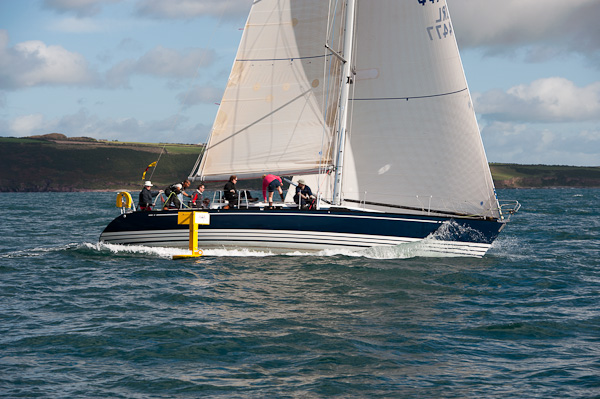

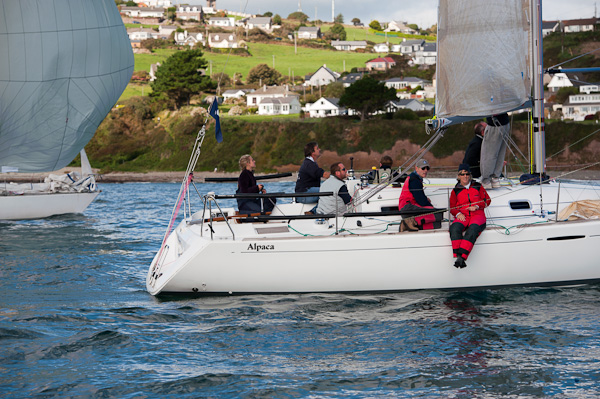
First Race Results on Royal Cork Site HERE
More Bob Bateman Photos on the Gallery HERE
O'Regan and Flanigan Win 420 Champs
There was an abundance of sailing talent at the start line and Saturday's sailing took place in 15 to 20kts of breeze with Rob Lehane and Andrew O'Donoghue taking the overnight lead from Richie Harrington and Robbie English with Emma Geary and Niamh Connolly third in a fleet of sixteen boats.
Day two was back to Cuskinny with light north westerlies and saw Jane Butler and Jenny Andreason taking the first race. Emma and Niamh won the fifth race and Cian O'Regan (KYC) and Scott Flanigan (Howth YC) took the final race thus winning the National Title. Rob Lehane was second with Emma and Niamh taking third position and First Girls Boat.
420 National Championships 2010
1 53156 Cian O'Regan M Scott Flanigan M 13 2 4 9 4 2 1
Cobh to Blackrock Race was Scorching Success
The racing was started from the beautiful Ketch Soubrette from the Naval Service Yacht Squadron Cove S.C. First off were the slow dinghies and the white sail and classic yachts and these presented no problem to the Race Officer. However, when it came to the turn of the cruisers, with a strong flood tide they charged the line, and a general recall ensued. The Race Officer then proceeded to start the J80s before having another attempt at the cruisers Zero to Class Four. This time a Z flag was flown and anyone over the line in the final minute would have a 20% penalty applied. Happily, all went well on this occasion with a clean start and although the breeze was light and flukey all boats managed to make the finish at Blackrock Castle before the time limit. The finishing boat was a former Aran Class Lifeboat, the Samuel J and the first boat to reach the line was Jim Sheerin of Royal Cork Yacht Club in his Catamaran, narrowly beating Eddie English in the Holy Grounder from Sail Cork. In days gone by Eddie used always be first to the finish line in his yellow Hobie. Happy memories!
The event played a big part in the Port of Cork Open Day and for the first time the race had the benefit of the Port of Cork City Marina. When the boats had completed the race at Blackrock Castle they proceeded right up to the city for the prize giving and other festivities planned. All the local towns and villages in and around Cork had events planned for the Open Day and what a difference to last year when the event was completely washed out.
What a coup for Cove Sailing Club with the wonderful reinvigoration of this much loved event. One of the nice things about this is that young children were to be seen sailing with their parents and being given the opportunity to helm all types of craft from Catamarans to Cruisers. It was that kind of event and a wonderful way to get youngsters interested in sailing and fostering a love of the sport.
Photos of the event on the Afloat Gallery HERE
SCORA Championships Set for Cove SC
The SCORA (South Coast Offshore Racing Association) Championships will take place out of Cove Sailing Club on September 25th/26. From September 24th any competitors travelling to this event and who will be entering the O'Flynn Exhams Solicitors Autumn Regatta the following week will be provided with berthage or moorings free of charge at the Royal Cork Yacht Club right through to the end of the Autumn League.
Royal Cork Pair Win Feva Irish Title
Strong winds cut short the RS Feva Irish Nationals and Open Championship on Dublin Bay today but before the north-westerly breeze took charge a 58 boat fleet was given a display of top class Feva saiing by visiting Royal Cork Yacht Club crew Brendan Lydon and Marc Cudmore. The pair finished the five race series with four results inside the top three and prevented a pot hunting Royal Yachting Association development squad from walking away with the Irish title.
The RS Feva is now one of Ireland's most popular two-handed intermediate dinghies. Full results from the weekend are downloadable below.
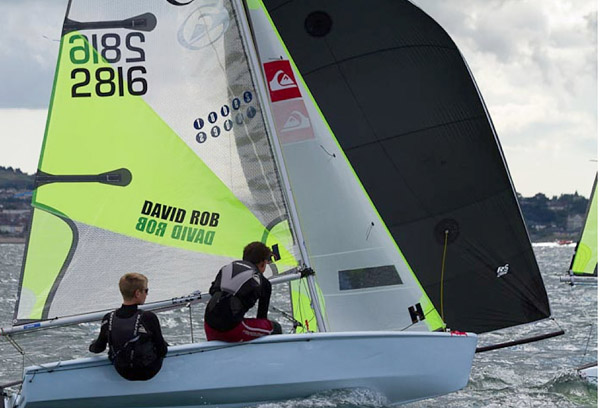
More Feva photo action on the Afloat gallery by Gareth Craig HERE.
Royal Cork Yacht Club, Leading Irish Yacht Club
Royal Cork Yacht Club
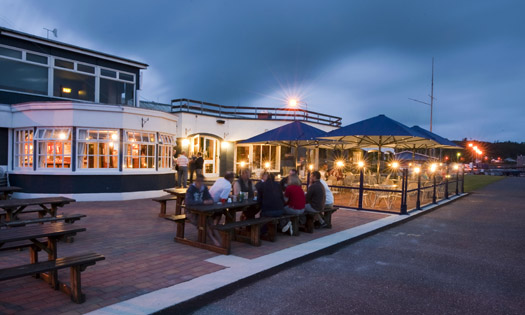
Royal Cork YC. Photo Bob Bateman
William O’Brien, the 9th Lord Inchiquin, and his five cohorts had the maritime inspiration to coin it The Water Club of the Harbour of Cork.
Now, a name-change and couple of port-swaps later, it’s one of Ireland’s most innovative and welcoming clubs with a membership totalling around 1,500 with 280 berths, which regularly hosts major world, European and Irish championships. If the planning authorities were a bit more lenient, it could extend its marina to 500 berths. Recently it elected Deirdre Tingle, it’s first lady rear admiral, who is in charge of dinghies. It has three representatives in the Optimist World/European team and one of its sailors – Peter O’Leary – along with Stephen Milne has secured a place at the forthcoming Olympics in the Star class. Always interested in recruiting new members, the club is involved in a primary school initiative locally where students are being taught sailing as part of their sixth class sports curriculum. From July 12th to 18th, Cork Week – the popular biennial sailing regatta and Ireland’s biggest – will be in town bringing with it sailors from all over the world to race six courses in 20-odd classes in what many refer to as one of the great fun and party regattas anywhere, once the serious competition has concluded on the water.
While the Royal Cork Yacht Club has full dining and bar facilities. there are a number of other options around Crosshaven, the peaceful sailing village in West Cork, that lies guard where the Owenabue River enters the sea at the mouth of Cork harbour. One of the landmark must-see pubs is Croinin’s on the Point Road harbour-front which, while a popular haunt for sailors, is also home to the Mad Fish seafood restaurant. Next door to the pub is Thecla’s gallery and craft shop which is well stocked with all sorts of craftwork by local artists including handmade candles, pottery, children’s clothing, paintings and jewellery.
Elsewhere the Moonduster Inn and Restaurant – also highly thought-of on the waterfront – Fusion, The Admiral Drake and the China Sea provide an eclectic choice for visitors eager to soak up the atmosphere, particularly around Cork Week. For those more interested in putting together their own meals, there’s the farmer’s market every Saturday in the village square.
Accommodation-wise, there isn’t really luxury on a grand scale with most offerings down the guesthouse avenue or small family hotels that have been in business a long time. A selection of what’s available can be checked out at www.crosshaven.ie and includes directions to most of those featured.
Cork Week: The World's Top Fun Regatta
Cork Week – The World's Top Fun Regatta
Since 1978 Cork Week has been setting the bar for Irish Sailing and Afloat Magazine has documented the growth of the biennial event over the past 30 years to the stage today where it is widely regarded as one of the world's top regattas. For all the latest news and updates on Cork Week click here.
Take a small sleepy fishing village. Add water (well, the Atlantic Ocean) and old-fashioned Irish charm. Stir in seven bars, three restaurants, 50 bands, 400 performers and 180 hours of entertainment. Bake in warm sunshine for one week every two years. Sprinkle with 7,000 high-earning visitors.
This is the recipe for success at Cork Week regatta – an icon of Ireland's summer sport that has a bigger reputation overseas than it has at home.
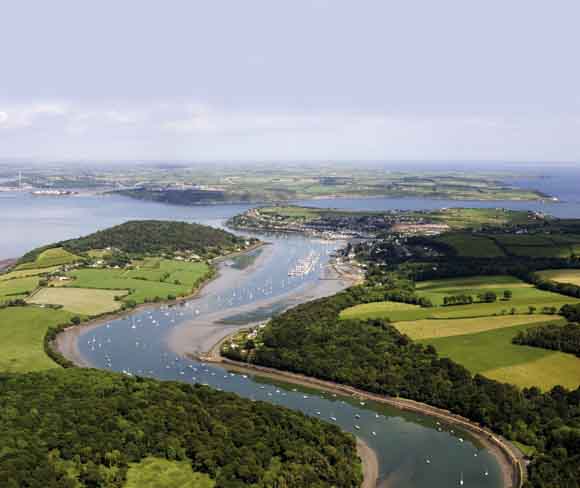
Above: Looking south towards Crosshaven. Photo: Bob Bateman
Competitors come from as far away as the US, Hong Kong, Australia, France, Germany and Belgium. 2006's regatta attracted first time entries from the Philippines, South Africa, Italy and Sweden but the mainstay of the biennial event is a huge representation from England, Scotland and Wales.
Cork Week, of course is not the only regatta of its kind in the world and many copycat events have sprung up across Europe. But Cork continues to have a special mix that lives up to its billing as the number one fun regatta in the world.
For a typical 450 entries, 80% of them would come from overseas, and they are heading here to race but also for the fun.
In many respects Cork Week, when it first started in 1986, took its inspiration from the success of Cowes Week on the Solent but from the beginning Royal Cork Yacht Club (RCYC) organisers wanted to do more than ape a British event.
They saw a gap in the regatta market and took a bold decision to do away with convention and rewrite the rules for sailing regattas. It sounds cliched some 23 years later but they wanted to produce a regatta that was run by sailors for sailors.
What this actually meant was they set about banning professional sailors from attending Cork at a time when regattas across Europe were suffering from the invasion of paid-to-sail crews. It was a situation that left amateur skippers and crews, representing the majority of the sailing community, tired of heading home without any silverware.
The plan was risky, of course, because pros were an influential bunch required to establish the regatta as a credible venue. Banning them was especially problematic for a remote venue on the outskirts of Europe where the high costs of transporting crew and equipment could have kept many away.
But the crews didn’t stay away and the ‘no-pro’ rule, as it became known, has worked in Cork’s favour. Amateur sailors embraced the idea and owners return to Crosshaven year after year to race against each other for a week of Corinthian fun.
Cork went one better by going back out to the professional circuit and inviting pros to a special restricted class within the week where they could race with each other.
In 2004, for example, it attracted some real professional glamour. American Roy Disney came to town, as did the German billionaire Hasso Plattner, both racing massive Z-86 racing machines around Cork harbour. It was a show stopper and put the glitz into Cork.
It hasn't all been plain sailing however. The Cork week organisation has had its difficulties. Four years ago the host club, the RCYC was so intent on having a good time that it lost money on the enterprise. Thankfully it’s now on a firm financial footing again and the event looks stronger than ever.
Around the same time, many Irish sailors began to think that Cork Week had become just the ‘The Solent on tour’.
They were turned off by the high prices of local accommodation for the week. Dublin sailors complained that the successful Crosshaven formula had been over cooked. They resented paying up to 500 Euro to share a bedroom for the week.
Thankfully that too has been ironed out with a bigger range of accommodation now on offer.
But perhaps in the crush most Irish sailors forgot to appreciate just what they have on their own doorstep. Nowhere was this point more clearly made than in early June when the world’s top offshore sailors called in unexpectedly to our south coast.
They came principally in search of wind in leg eight of the Volvo Round the World race. They found little wind, unusually, but before they left they wrote prose worthy of a Failte Ireland copywriter.
In his log, navigator Simon Fisher wrote: “Our day started sailing in and out of the mist rolling down off the hills and, as the sun rose and the mist burnt off, it gave way to spectacular views of rolling green hills and a weather-beaten rocky coastline. With castles and towers stationed on each headland, it gives you the feeling of sailing through a scene out of Lord of the Rings.”
With endorsements like that, it’s easy to see why Crosshaven will teem again with sailors and supporters for a festival of sailing that’s more like Galway Races on water than a regular Irish sailing regatta.
Although Cork Week's not all about rubbing shoulders with serious money, it is hard to ignore the economic value of the event.
Putting a figure on it can be difficult but Cork Week chairman Ian Venner reckons it is worth 10 million Euro to the local economy. It's like Ireland –v– England at Lansdowne road in an otherwise sleepy fishing village.
You can read Cork Week's own history of the event here.
Royal Cork Yacht Club, the oldest Yacht Club in the World
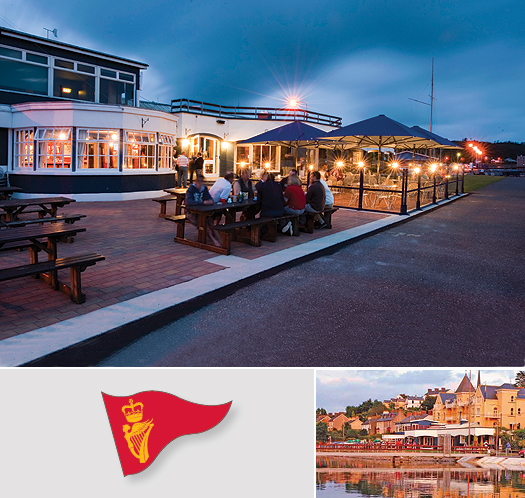
The Royal Cork Yacht Club
History
Some time in the early 1600s, the idea of sailing for private pleasure started to take root in the Netherlands. Later that century, during the Cromwellian years, King Charles II of England was in exile in the Netherlands and while there he became aware of this new and exciting pastime. In 1660 after his restoration to the English crown and return from exile, Charles was presented with a yacht called Mary by the Dutch, which he sailed enthusiastically on the Thames. Soon several of his courtiers followed his example and we feel pretty certain that one of them was Murrough O’Brien, the 6th Lord Inchiquin (Murrough of the Burnings). We know that not only had he attended the court of King Charles from 1660 to 1662, but also that he had been created the 1st Earl of Inchiquin by Charles in 1664. We also know that private sailing started to become popular in Cork Harbour shortly after his return, quite possibly because of his direct encouragement. In any case, by 1720, interest in the sport had progressed so much that his great-grandson, the 26 year old William O’Brien, the 9th Lord Inchiquin, and five of his friends got together to formalise their activities and in so doing established ‘The Water Club of the Harbour of Cork'. This club is known today as the Royal Cork Yacht Club and it is the oldest yacht club in the world.
They based themselves in a castle on Hawlbowline Island, the lease of which Lord Inchiquin held. From that castle they regulated their sailing, membership and dining affairs according to a set of rules known to us today as ‘The Old Rules’.
In the early years the majority of club sailing activity took the form of sailing in various formations, copying the manoeuvres of the navies of the day. They communicated with each other by means of flying different flags and firing cannons. Each display and sequence of flags or guns meant something and every yacht owner carried a common signal book on board, which allowed them to communicate with each other. Paintings from 1738 in the possession of the club show club yachts carrying out such manoeuvres.
Shortly before 1806 the club moved to the nearby town of Cove as the British Admiralty decided that they had a greater need for Hawlbowline Island than we had. The American Revolution and then later on the French Revolution, would have been significant factors in the Royal Navy’s decision to build up their presence in the safe and strategic harbour of Cork. Kinsale had been the main naval centre on this coast up until this time but that harbour had begun to silt badly causing problems for warships which in addition had become bigger with deeper draughts.
By 1806 the Water Club of the Harbour of Cork had started to refer to itself as the Cork Harbour Water Club. During the 1820s, following the fashion of the few other clubs that had emerged by then, it changed its name to include the word ‘Yacht’ and dropped the word ‘Water’ and became known as the Cork Harbour Yacht Club. Later on that decade it dropped ‘Harbour’ and became the Cork Yacht Club. In 1831 King William IV granted the club the privilege of using the prefix ‘Royal’ and it became known as the Royal Cork Yacht Club.
The Club had been using various premises in Cove as clubhouses but eventually, in 1854, it moved into a magnificent new building which it had built on land given to it by the then Admiral, J.H. Smith Barry. The building, which stands directly onto the waterfront, was to become not only a major yachting centre but also an essential meeting place for Cork society.
By mid century membership was keenly sought after and club records show that many candidates were disappointed. One who was fortunate to be admitted was Prince Ferdinand Maximilian of Austria, later to be Emperor of Mexico. Prince Ferdinand was a brother of Emperor Franz Joseph and was the founder of the Imperial Austrian Navy. A special meeting of the General Committee was convened on 30th November 1858 to consider if Prince Ferdinand should be allowed to go forward for ballot for membership. It was felt by many of the members that ‘the admission of Foreigners’ into the club might cause the Lords of the Admiralty to withdraw some of our privileges. After the matter was discussed for some time he was allowed to go forward and was in due course electedand admitted.
One of the very first sporting heroes, Sir Thomas Lipton, who challenged for the America’s Cup sailing his famous series of yachts called Shamrock, was admitted to the club in 1900.
By the 1960s changing economic and social patterns made Cobh less and less attractive as a base for the club. In 1966 the Royal Cork and the Royal Munster Yacht Clubs agreed to merge and the Royal Cork moved to its present premises in Crosshaven assuming the title ‘The Royal Cork Yacht Club, incorporating the Royal Munster Yacht Club’.
In the 1970s and 80s the very pinnacle of sailing competition was the Admirals Cup which was an international competition based on teams of three boats. The Royal Cork was the pivotal point for the very competitive Irish teams of those years, the right designer, builders, sail maker, crews, and owners with vision all came together at the same time and gave nations with greater resources cause for reflective thought.
The Royal Cork Yacht Club today encompasses a wide variety of sailing activities from young kids in their Optimist and Mirror dinghies sailing right through the winter months to the not-so-young kids racing National 18s and 1720s during the remaining nine months. There is also enthusiastic sailing in 470s, Int. 14s, Lasers, Laser IIs and other dinghies. The larger keelboats race on various courses set in and around the Cork Harbour area for club competitions. They also take part in events such as the Round Ireland Race, Cowes Week and the Fastnet Race.
In many far off waters, right across the globe, overseas club members proudly sail under the Royal Cork burgee. The club has a significant number of cruising members, many of whom are content to sail our magnificent south and west coasts. Others head north for the Scottish islands and Scandinavia. Some go south to France, Spain, Portugal and the Mediterranean. The more adventurous have crossed the Atlantic, explored little known places in the Pacific and Indian Oceans while others have circumnavigated the globe.
Looking forward into the 21st century, the Royal Cork goes from strength to strength, total membership is around 1500, our facilities are unparalleled in Ireland and continue to expand, major World, European and Irish Championships are hosted in the club regularly. Cork Week, which is held every two years, is regarded as Europe’s best fun regatta bar none and attracts contestants from all over the world. Recently the Royal Cork was proud to host the ISAF Nations Cup. The activities of the club are regarded as a major tourism asset for the Cork area and significantly contribute to the economy of Crosshaven. The Royal Cork may be almost 300 years old but it is still vibrant, progressive and innovative – just as it was in 1720.
(Details and image courtesy of the Royal Cork Yacht Club and Bob Bateman)
Buy the RCYC History Book here
Royal Cork Yacht Club, Crosshaven, Co. Cork. Tel: +353 21 483 1023, fax: +353 21 483 1586, email: [email protected]
Have we got your club details? Click here to get involved



























